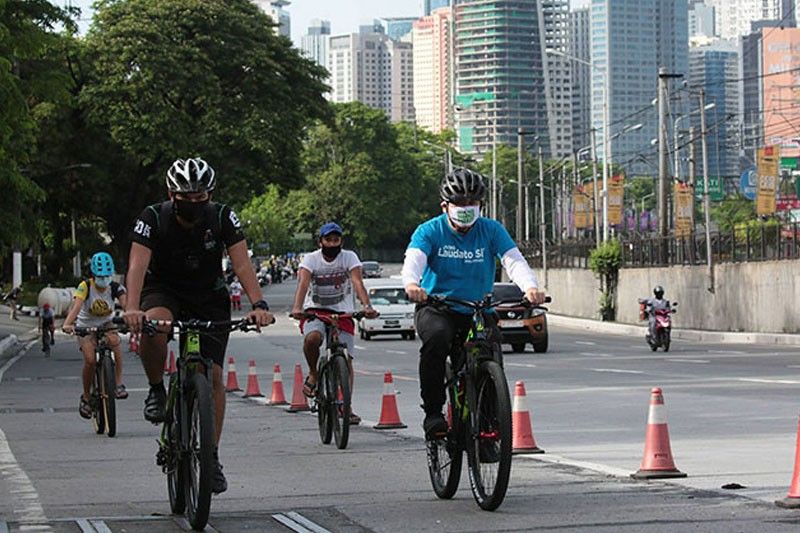The Road Ahead: Bike lanes a good start but more infra, policy changes needed

This story is part of a series on Metro Manila's cities and how they are promoting cycling and the use of bicycle lanes
MANILA, Philippines — When the coronavirus pandemic shuttered most of public transportation in Metro Manila, thousands looked to cycling to get to work. That was in early 2020.
Against the backdrop of the coronavirus-induced quarantines, the ripple effect in the cycling community has sustained itself to this day. In 2021, the Department of Transportation oversaw the construction of 313.12 kilometers of bike lanes in Metro Manila alone.
According to the Social Weather Stations, 42% of households or an estimated 2.6 million families claimed they were biking more frequently now than before.
As in most of the government’s pandemic response, though, the heavy lifting was given to the local government units. City administrations, in turn, worked in silos and came out with different takes on how to repurpose their roads for the biking public.
Advocates have long called for a reimagination of how we use our roads. But what does this actually mean on the ground, and what can we learn from each others' individual efforts?
Lanes are there, but infrastructure, policy and enforcement yet to catch up
Philstar.com spoke to the changemakers themselves, the transportation offices leading the charge in Metro Manila’s local government units. A number of key themes arose in all those conversations:
- LGUs and cyclists alike felt the crunch from differing design philosophies among each other and with the national government agencies
- The prevalent car-centric and anti-cyclist culture among motorists translated to continued violations of bike lane rules, mostly by motorists
- Politics was still among the main hindrances stopping city halls from going all-in on their bike lane networks
Of note, local government units said the differing designs were okay for now, as long as they could work around them and the initial bike lanes have already been laid down.
We asked cycling and transportation advocates: what else is missing in our local bike lanes today?
The first thing is connectivity, which has everything to do with the city hall's working relationship with the national government agencies such as the Department of Transportation, Metro Manila Development Authority, and Department of Public Works and Highways.
Quezon City, for instance, said it had to settle for a shared outer lane simply because of how the physical conditions governing the roads themselves.
For instance, the industrial and narrow Quirino Highway differs largely from wider Commonwealth Avenue. As of this writing, the bike lanes in Commonwealth don't actually reach the ones in Quirino.
The lanes have been laid down and are very much works in progress across the capital region, but the lack of full connectivity also has to do with differing design philosophies between local governments and the national agencies.
One city transport office said that the DPWH prioritized bollards and separation devices while the city used other forms of separation such as buffers. The national roads in and around Quezon City do not have buffers.
San Juan said it preferred using bollards because these were cheaper and easier to replace, though the cities bordering it used concrete barriers which cyclists noticed as they moved from city to city.
Anton Siy, Pasig City's chief transport planner also called attention to the infrastructure still needed to serve commuters using those lanes. This meant putting up bike parking first and foremost, though other cities opted to put up solar-powered bike pit stops too.
"I think they're really easy to implement because no one sees them as much and nobody is annoyed by bike racks. It's all upside and no downside...strong cyclists can cycle without bike lanes, but they won't bike at all if there's nowhere to park," he said.
He added that it could be high time for the government to revisit the National Building Code and look into legislating bicycle parking instead of car parking as something that's essential.
National bike lanes generally 'substandard,' advocates say
In a statement earlier this month, nonprofit AltMobility PH said that "permanent and protected bike lanes remain insufficient, and fails to provide a useful network for bike commuters."
It raised the alarm on what it said was the national government's "underestimation" of the transportation needs of workers going back to their offices under Alert Level 1. The group made a number of recommendations, saying:
- The quality of bike lanes is substandard and risks the safety of users with the tight spaces, and numerous potholes and obstructions;
- Enforcement to ensure unobstructed bike lanes is lacking, resulting to bike lanes often blocked by motor vehicles;
- Availability of end-of-trip facilities such as bike parking in establishments and offices, and encouraging this through incentives for establishments that provide it
Sought for comment on the long queues that commuters faced over the past week as on-site work began for a number of industries, The Passenger Forum convenor Primo Morillo also highlighted the need for stricter enforcement that centered on the needs of the cycling community.
He said the extent to which infrastructure projects can serve commuters hinges on just how well the rules surrounding them are enforced.
"We really need to look at how pedestrian-friendly and bike-friendly they are, not just infrastructure but also policies," he said in Filipino in a phone call with Philstar.com.
"There's always the question, for example, of why we're so tight in enforcing helmets when that just discourages biking, when in fact the helmet seldom protects the biker when it's up against fast cars. The way to protect a bike is to impose speed limits and to penalize cars going inside the bike lanes. That's what the answer is."
Philstar.com spoke to cyclist Janardan Ladyong to ask about what else commuters need when biking along local government roads. Janardan runs the Facebook page Manila Bike Commuter, where he posts videos of the daily commute from a bike commuter’s perspective.
Law enforcement agencies, in particular, have had a lot of catching up to do over the coronavirus pandemic. In April 2021, the Department of Health had to issue a statement reminding police personnel that cyclists and other active transport users are exempted from the face shield requirement.
READ: DOH reminder: Cyclists, others active transport users not required to wear face shields
This only came after many had already been arrested and fined for not wearing the plastic face covers which were required at the time. Health experts were already questioning the efficacy of the face shields in stopping coronavirus transmission, while cyclists and motorcycle riders alike were questioning the safety of wearing them on the road.
Ladyong agreed that more effective enforcement is needed, pointing out that painted bike lanes are only effective along roads with six or more lanes and only during off-peak hours.
"During rush hour, even wider roads are not safe since motorists will occupy even the bike lane. Protected bike lanes are still the best in any city. They give the impression that the bike lanes are exclusive and should not be used by motor vehicles. The type of protection still varies though, and unfortunately only the ones with concrete are most effective, while ones with plastic or movable bollards are often run over by motorists," he said.
Ladyong said that close passes from motorists are a common experience among the cycling community, whether the roads include a buffer or not.
"Buffered or not, you will still experience close passes from motorists. The problem is that they’re not followed by motorists anyway... I have read and heard stories from fellow bicycle users who were berated or cursed at by motorists just by being on the road. Some were even threatened to get run over," he said.
"Motorists feel that the bike lanes have taken what’s ‘theirs’, so they tend to be more aggressive to bicycle users traversing these areas."
'Design matters': It's a start—but it doesn't end there
Though Ladyong admitted that the three cities covered in the series "are laudably the most active in maintaining and improving their bike lane networks," he disagreed with the notion that design differences across local and national roads shouldn't be a deterrent as long as bike lanes are available for cyclists.
"Design matters a lot in shaping behavior. In other countries, they have what’s called 8-80 in desiging safe bike lane networks. Until you can say that a bike lane is safe to use for people as young as 8 years old, and up to the elderly, then it isn’t safe," he said in an online exchange.
"For now these current bike lanes that we have help people who are already bike commuting, but they need to entice people on cars (the main cause of traffic congestion), for us to say that these bike lanes are indeed effective."
Still, he said that the present bike lanes have made significant strides in legitimizing bike commuting across the metro.
"For now these current bike lanes that we have help people who are already bike commuting. The current bike lanes to a certain extent have reduced the misconception that bicycle users are prohibited on highways and major thoroughfares," he said.
"But they also need to entice people on cars (the main cause of traffic congestion), for us to say that these bike lanes are indeed effective. The momentum is already there; it just has to be continued and the bike lane networks should be improved and maintained."
- Latest
- Trending



































